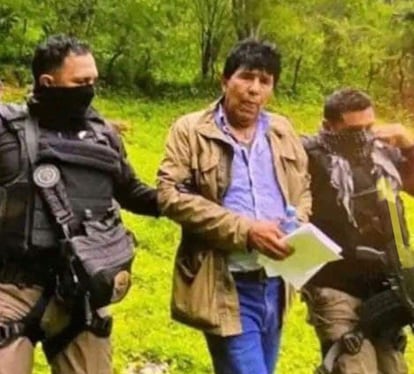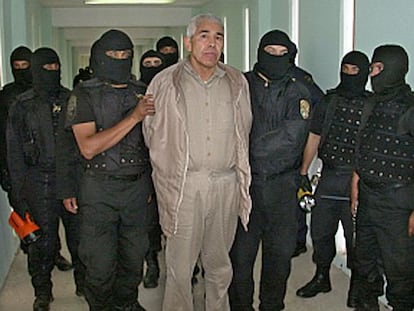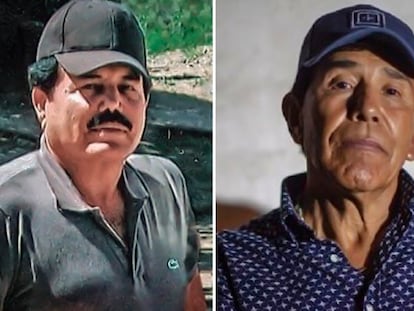Caro Quintero’s life behind bars: The story of Mexico’s ‘Narco of Narcos’
The drug lord, detained in a US prison since February on charges of killing a DEA agent, is waiting to find out whether he will be sentenced to death or life imprisonment
In the only interview he ever gave, Rafael Caro Quintero — Mexico’s “Narco of Narcos” — answered with terrifying simplicity a question that almost seemed like a formality, about his role in the Guadalajara Cartel: “I didn’t realize anything about the cartel or all that until I was already in prison.” It was 2016. Caro Quintero, a pioneer of industrial-scale marijuana cultivation, violent and bloodthirsty, capable of rebuilding his criminal empire after 28 years behind bars, suddenly seemed like a confused old man. The cartel? Just fabrications.
But it didn’t matter what he said. Six years later, justice came knocking once again, and he was sent back to prison. In February, Mexico extradited him to the United States, and now prosecutors only debate is about the final fate of the 72-year-old: the death penalty or life imprisonment.
It’s been a long, bumpy road, gilded by the cracks in Mexico’s justice system. First arrested over 40 years ago for the murder of DEA agent Enrique “Kiki” Camarena, among other crimes, he was released from prison in 2013 after a court ruled that his trial was flawed. According to the judges, Caro Quintero should have been tried in federal court, not state court. So, they let him go. Two years later, the Mexican Supreme Court ordered the same court to reconsider its decision. Under pressure from public opinion and both the Mexican and U.S. governments, the court reversed the decision. By then, the criminal had vanished into the mountains of northwestern Mexico.
The narco prince — a title that reflected his founding role in Mexico’s criminal aristocracy — ran as far as he could. He sought refuge in his old northern strongholds and became powerful again in northern Sonora, aided by his nephews. He went back to what he had done so many times before: trafficking.
Leaked army documents, released a couple of years ago by the hacker collective Guacamaya, placed him in several municipalities in that state — Caborca, or the waters of Puerto Peñasco and San Luis Río Colorado — within striking distance of the United States. It was there he had taken his first steps 50 years earlier. As academic Ben Smith notes in his monumental book on the Mexican drug trade, The Dope, one of Caro Quintero’s first arrests was for storing marijuana in San Luis, in the late 1960s and early 1970s.
Those were different times. When he returned to the game, the fentanyl era had taken over; methamphetamine, so new in the 1990s, had become the trafficking staple, and marijuana was being legally sold in many U.S. stores.
Then there was the evolution of organized crime. His two old partners — Ernesto Fonseca, aka Don Neto, and Félix Gallardo — were also serving sentences for the Camarena case. Their Sinaloan successors, Joaquín “El Chapo” Guzmán and Ismael “El Mayo” Zambada, were constantly on the run — especially the former, who would be captured in 2016.
In the years that followed, the region mirrored a now-common national pattern: the fragmentation of criminal groups, factional infighting, and the diversification of illicit economies. Caro Quintero, for his part, dyed his hair black — a symbol of a time that was slipping away from him.

This is how he appeared in the video released by the government at the time of his last arrest in 2022: a man in his seventies with jet-black hair. Authorities captured him in a small town in the municipality of Choix, deep within the Golden Triangle — the rugged region spanning Sinaloa, Durango, and Chihuahua, the mythical cradle of drug trafficking in Mexico.
In The Dope, Ben Smith recounts how, 90 years ago, a local strongman, Melesio Cuén, and a Chinese healer who took the name Juan Amarillas, taught the area’s peasants how to cultivate poppies, the source of opium gum. But that’s another story. Caro Quintero, a native of the region — like El Chapo and Don Neto — tried to hide in the brush, but there was no fooling the soldiers.
In recent years, it’s been his lawyers’ legal maneuvering that has taken center stage. The threat of extradition loomed over Caro Quintero. Perhaps that’s why, in the 2016 interview, he offered an apology “to the United States and the DEA,” the U.S. anti-drug agency. “If I made any mistakes, I ask for forgiveness,” he said.
His lawyers threw every possible obstacle in the path of his extradition to the U.S. At one point, they even claimed that Caro wasn’t really Caro — a classic tactic in criminal defense. No one believed it, but the ploy delayed the process for three years. Then, this past February, the Mexican government — adept in its own legal gymnastics — bypassed extradition formalities by sending a wave of alleged criminals north, a gesture meant to appease the Trump administration’s demands.
Once on U.S. soil, the DEA hailed his presence as a long-awaited moment of justice. In the U.S., there is no bigger culprit than Caro Quintero, who is accused of conspiring to kill Agent Camarena — a pivotal moment in the history of the drug war. According to the official account, Caro and Don Neto masterminded the kidnapping, torture, and killing of the agent in Guadalajara in early 1985. That much is not disputed.
The motive, the story goes, was the seizure of tons of marijuana from one of Caro Quintero’s ranches a year earlier. But over the years, researchers — including some from the DEA itself — along with journalists and scholars, have argued that this wasn’t the real reason. They point instead to a CIA conspiracy, tied to the agency’s efforts to fund the Nicaraguan Contras at the time.
Again, that’s another story. What’s certain is that Caro Quintero now awaits trial, with only one real question remaining: will prosecutors seek life in prison or the death penalty? In addition to the Camarena case, Caro Quintero faces charges of drug trafficking and criminal conspiracy. Hope is unlikely to be with him during his time in prison. The U.S. justice system made its stance clear the moment he arrived. The DEA agents who took custody of the Mexican drug lord reminded him that they hadn’t forgotten. The handcuffs they used were the very same ones used by Camarena 40 years earlier.
Sign up for our weekly newsletter to get more English-language news coverage from EL PAÍS USA Edition
Tu suscripción se está usando en otro dispositivo
¿Quieres añadir otro usuario a tu suscripción?
Si continúas leyendo en este dispositivo, no se podrá leer en el otro.
FlechaTu suscripción se está usando en otro dispositivo y solo puedes acceder a EL PAÍS desde un dispositivo a la vez.
Si quieres compartir tu cuenta, cambia tu suscripción a la modalidad Premium, así podrás añadir otro usuario. Cada uno accederá con su propia cuenta de email, lo que os permitirá personalizar vuestra experiencia en EL PAÍS.
¿Tienes una suscripción de empresa? Accede aquí para contratar más cuentas.
En el caso de no saber quién está usando tu cuenta, te recomendamos cambiar tu contraseña aquí.
Si decides continuar compartiendo tu cuenta, este mensaje se mostrará en tu dispositivo y en el de la otra persona que está usando tu cuenta de forma indefinida, afectando a tu experiencia de lectura. Puedes consultar aquí los términos y condiciones de la suscripción digital.
More information
Archived In
Últimas noticias
Welcome to the post-religion era: The idea of Christianity as the absolute truth has become obsolete
‘I thought you would like it’: The risky sexual practice popularized by TV shows and TikTok
The digitalization of tourism: ‘They promise experiences and gave us the worst possible one’
Mexican peso defies uncertainty with forecasts of a new period of stability in 2026
Most viewed
- Sinaloa Cartel war is taking its toll on Los Chapitos
- Oona Chaplin: ‘I told James Cameron that I was living in a treehouse and starting a permaculture project with a friend’
- Reinhard Genzel, Nobel laureate in physics: ‘One-minute videos will never give you the truth’
- Why the price of coffee has skyrocketed: from Brazilian plantations to specialty coffee houses
- Silver prices are going crazy: This is what’s fueling the rally











































